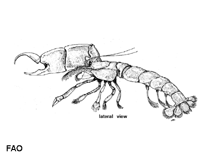Trypaea australiensis Dana, 1852
Australian ghost shrimp| Native range | All suitable habitat | Point map | Year 2050 |

|
| This map was computer-generated and has not yet been reviewed. |
| Trypaea australiensis AquaMaps Data sources: GBIF OBIS |
Классификация / Names народные названия | синонимы | CoL | ITIS | WoRMS
Malacostraca | Decapoda | Callianassidae
Environment: milieu / climate zone / пределы глубины / distribution range экология
; солоноватоводный. Subtropical; 18°S - 40°S, 144°E - 154°E (ссылка 4)
Distribution страны | регионы FAO | Ecosystems | места находок | интродукции
Indo-West Pacific: Australia.
Length at first maturity / Size / Weight / Возраст
половая зрелость: Lm ? range ? - ? cmCommon length : 6.0 cm TL самец/пол неопределен; (ссылка 4); наибольший возраст (опубликованны данные): 2.00 годы (ссылка 2823)
Краткое описание морфология
Life cycle and mating behavior половая зрелость | размножение | нерест | Eggs | Fecundity | Larvae
Основная ссылка
ссылки | координатор | соавторы
Holthuis, L.B. 1991 FAO Species Catalogue. Vol. 13. Marine lobsters of the world. An annotated and illustrated catalogue of species of interest to fisheries known to date. FAO Fish. Synop. 125(13):292p. Rome: FAO. (ссылка 4)
Статус Красного Списка МСОП
(ссылка 130435: Version 2025-1)
Статус СИТЕС (ссылка 108899)
CMS (ссылка 116361)
Угроза для людей
Использование человеком
наживка: usually
| FishSource |
инструменты
дополнительная информация
ресурсы в Интернет
BHL | BOLD Systems | CISTI | DiscoverLife | FAO(Publication : search) | Fishipedia | GenBank (Геном, Нуклеотид) | GloBI | Gomexsi | Google Books | Google Scholar | Google | PubMed | Tree of Life | Wikipedia (Вперёд, поиск) | Zoological Record



